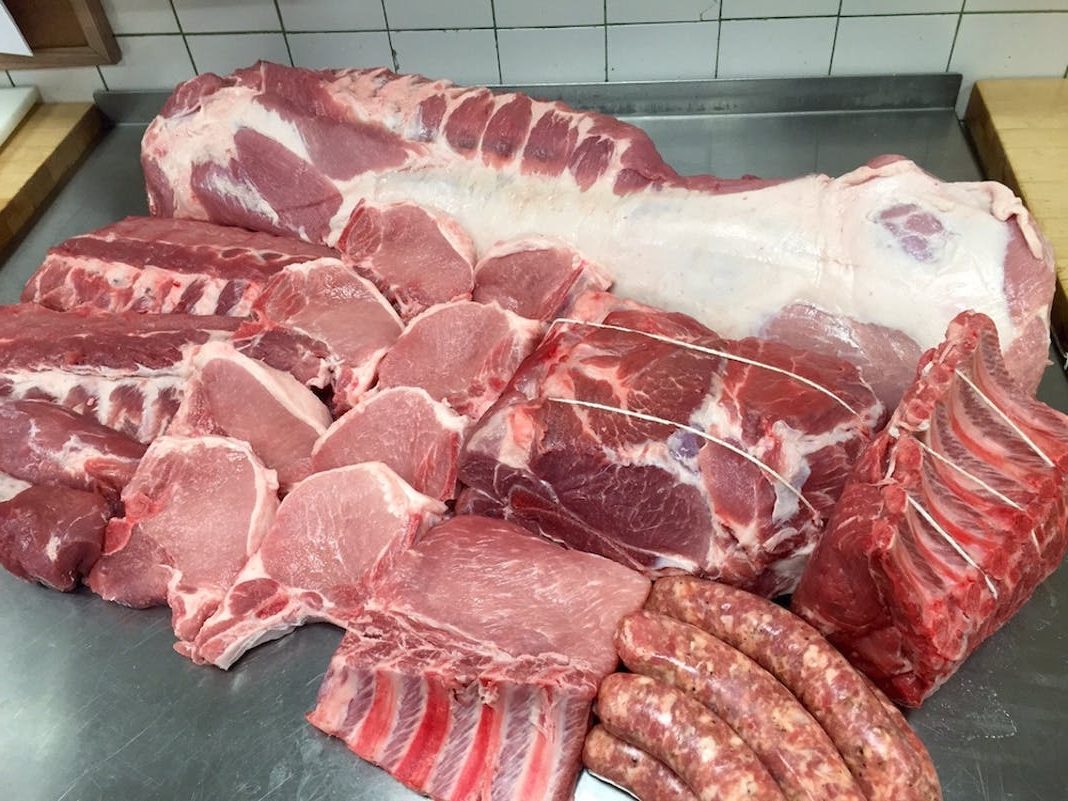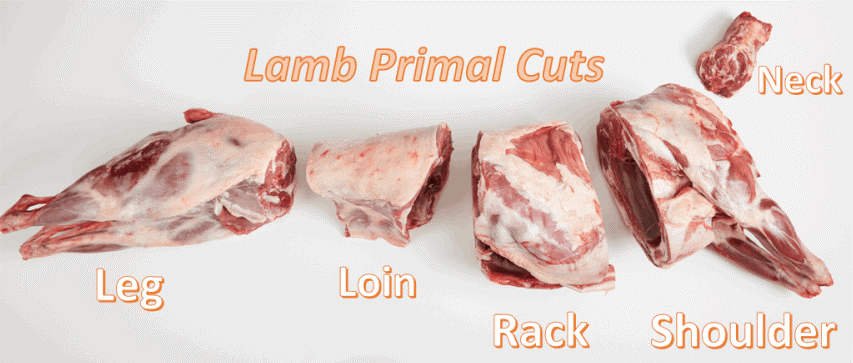A Brief details about Meat
What is Meat?
Meat is the flash of animal or “the parts of animals fit for human consumption. “used for food including the dressed flesh of cattle, sheep, or goats, pork and other edible animals, with the exception of fish & shell fish, poultry, and wild game animals. Meat is mostly the muscle tissue of an animal. Edible offal consisting of organs and non-skeletal muscle tissues also are considered meat. Even though bones are not independently considered meat, when they are associated with a bone-in portion of meat such as a steak or chop, bones would be considered meat. All livestock is considered red meat. This includes beef, pork, goat, and lamb whereas poultry Commonly referred to as white meat, poultry includes chicken and turkey.
Most animal muscle is roughly 75% water, 20% protein, and 5% fat, carbohydrates, and assorted proteins. Muscles are made of bundles of cells called fibers. Each cell is crammed with filaments made of two proteins: actin and myosin.
| Actin Myosin |
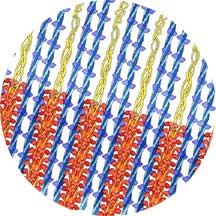
Ample anthropological evidence exists to show that meat has served as a food source for humans for thousands of years. Meat is an important source of essential amino acids (proteins), iron, B vitamins as well as other nutrients and minerals. Originally, humans hunted animals for meat and non-meat products, but today, animals used for food and sold into commerce are slaughtered under strict guidelines from various governing agencies. These agencies ensure the animals are put to death in a humane manner and also ensure the animals are free of disease at the time of death and the carcasses are kept clean throughout the dressing process to provide wholesome products for consumption.
What is Red Meat.
Red meat is defined as a meat derived from farm reared mammals which is normally red when raw. This includes beef, lamb, pork, goat and veal. It contains numerous vitamins and minerals that are essential for a balanced diet. Red meat is a good source of high quality protein with 20-24 grams of protein per 100 grams. Protein in red meat contains amino acids which is essential for growth, maintenance and the repair of the body and also provide energy. Lean raw beef contains only 4.3% fat, lean raw pork only 4% fat whereas lean raw lamb contains only 8% fat. Red meat is an excellent source of selenium. This in combination with B6 provides an essential balance of nutrients that are vital for fertility, both in men and women. However, red meat can also assist men to achieve optimal fertile health. Lean meat provides a good amount of iron. Red meats are loaded with B-complex vitamins, particularly B12 and other essential B vitamins, like Vitamin B6, thiamine, folate, riboflavi, niacin and pantothenic acid.
How does Muscles turn into meat?
After an animal is slaughtered, blood circulation stops, and muscles exhaust their oxygen supply. Muscle can no longer use oxygen to generate ATP and turn to anaerobic glycolysis, a process that breaks down sugar without oxygen, to generate ATP from glycogen, a sugar stored in muscle.
What is Rigor Mortis & How to prevent it?
The breakdown of glycogen produces enough energy to contract the muscles, and also produces lactic acid. With no blood flow to carry the lactic acid away, the acid builds up in the muscle tissue. If the acid content is too high, the meat loses its water-binding ability and becomes pale and watery. If the acid is too low, the meat will be tough and dry.
Lactic acid buildup also releases calcium, which causes muscle contraction. As glycogen supplies are depleted, ATP regeneration stops, and the actin and myosin remain locked in a permanent contraction called rigor mortis. Freezing the carcass too soon after death keeps the proteins all bunched together, resulting in very tough meat. Aging allows enzymes in the muscle cells to break down the overlapping proteins, which makes the meat tender.
Why we consume meat
People who choose to eat meat often cite three reasons:-
- The first cited reason for consuming meat is that it tastes good and has a desirable flavor.
- meat consumption is often associated with social status or is enjoyed during times of celebration or special occasions.
- Finally, meat is consumed because it has desirable nutritional benefits and supports human health.
What happened when meat is cooked.
Individual protein molecules in raw meat are wound-up in coils, which are formed and held together by bonds. When meat is heated, the bonds break and the protein molecule unwinds. Heat also shrinks the muscle fibers both in diameter and in length as water is squeezed out and the protein molecules recombine, or coagulate. Because the natural structure of the protein changes, this process of breaking, unwinding, and coagulating is called denaturing.
Generally speaking, meat offers excellent nutritional value and provides a good range of essential nutrients. Its primary benefit is, of course, protein, along with its stores of essential amino acids and collagen. Most meats contain high levels of vitamin B12, B6, K, as well as zinc, riboflavin and iron. However, meat is very high in fat, low in carbohydrates, and contains no fiber. The fat content of meat can vary widely depending on the species and breed of animal, the way in which the animal was raised, including what it was fed.
composition and structure of the meat.-
Meat muscle, which is what we eat, is made of fibres, bound together with connective tissue, that are mainly linked to other groups of muscles or directly to the animal’s bone structure. Muscle contains 60% to 70% moisture, 10% to 20% protein, 2% to 22% fat, and 1% ash, depending on type and species. Connective tissue is composed of the two proteins: collagen and elastin.
Tendons are made up of mostly collagen. When tough cuts of meat are cooked with moisture the collagen changes to gelatine, and gelatine is soluble. It is this change from collagen to gelatine which makes the meat more tender. Collagen is creamy white in colour. Ligaments are made up of mostly elastin. Unlike collagen, it is insoluble. It is quite a tough protein, Elastin is yellow in colour.
The primary nutrient found in meat is protein. Protein is composed of amino acids, which build and maintain all tissues, forms an important part of enzymes, hormones and body fluids, and supplies energy. Excess protein is converted to fat and stored.
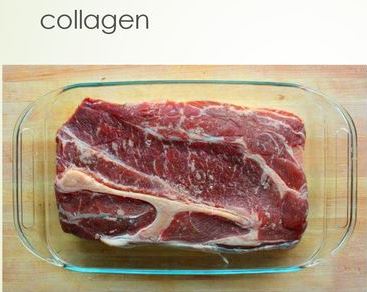
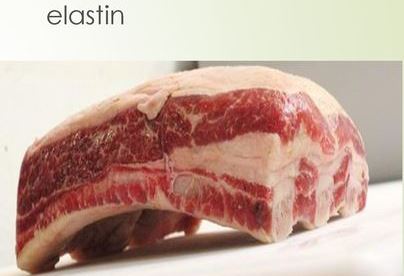
Meats in general are high in cholestrol than fish. In the discending order of cholestrol content, pork or products of pork in all forms are highest followed by beef, sheep / lamb and chicken.
What is Collagen?
Moist heat turns collagen into gelatin and water. Moist heat at low temperatures for a longer time is most effective in creating a tender, juicy finished product. Meat in an acid mixture or adding an acid such as tomato or wine to the cooking liquid helps tenderize the collagen.Enzymes are naturally present in meats. They break down the connective tissue and some other proteins as the meat ages. These enzymes are inactive at freezing temperatures, slow acting under refrigeration, active at room temperature and destroyed by heat above 140°F (60°C).
Tenderizers are enzymes such as papain (extracted from papaya) that are added to meats by the cook, or injected into the animal before slaughter. Exercise care when using enzyme tenderizers. Too long an exposure at room temperature can make the meat undesirably mushy.
What is Elastin?
Older animals have a higher proportion of elastin than younger animals. Cooking does not break down elastin. Tenderizing can only be accomplished by removing the elastin (cutting away the tendons) and by mechanically breaking up the fibers as in pounding or cubing the meat, grinding (hamburgers) or slicing the cooked meat thinly against the grain.
What is Green meat?
Green meat simply means it does not have sufficient age to be considered acceptable. When an animal is slaughtered the carcass stiffens and undergoes a process called “rigor mortis.” If the meat is frozen at this point it is called “green meat” and can be tough and a bit flavorless. If you wait to freeze the meat (but still keep the carcass cold, just not frozen) till after rigor mortis has passed a few days later your meat has a much better quality.
Why ageing is required in meat;-
Enzyme action continues in muscle tissue even after meat is no longer green. This tenderizes the meat even more and develops more flavour. Holding meats in coolers under controlled conditions to provide time for this natural tenderizing is called ageing. Beef and lamb can be aged because high quality carcasses have enough far cover to protect them from bacteria and from drying. Veal had no fat cover so it is not aged. Pork does not require ageing.
Ageing increases tenderness and flavour. An off taste is not characteristic of aged meat. If meats smell or tastes spoilt, it probably is. Sometimes meats in Cryovac have a musty aroma when first opened but this disappears soon.
Meat Grading in India.
In the Indian meat industry at present there is No grading system for Red meat production unlike the grading system followed in developed countries such as USA & European countries. In USA all meat sold for human consumption are inspected for wholesomeness to ensure they are slaughtered and processed according to safe and sanitary standards. A round stamp located on the animal’s carcass, or affixed to packages of processed meats, indicates these products are safe to consume.
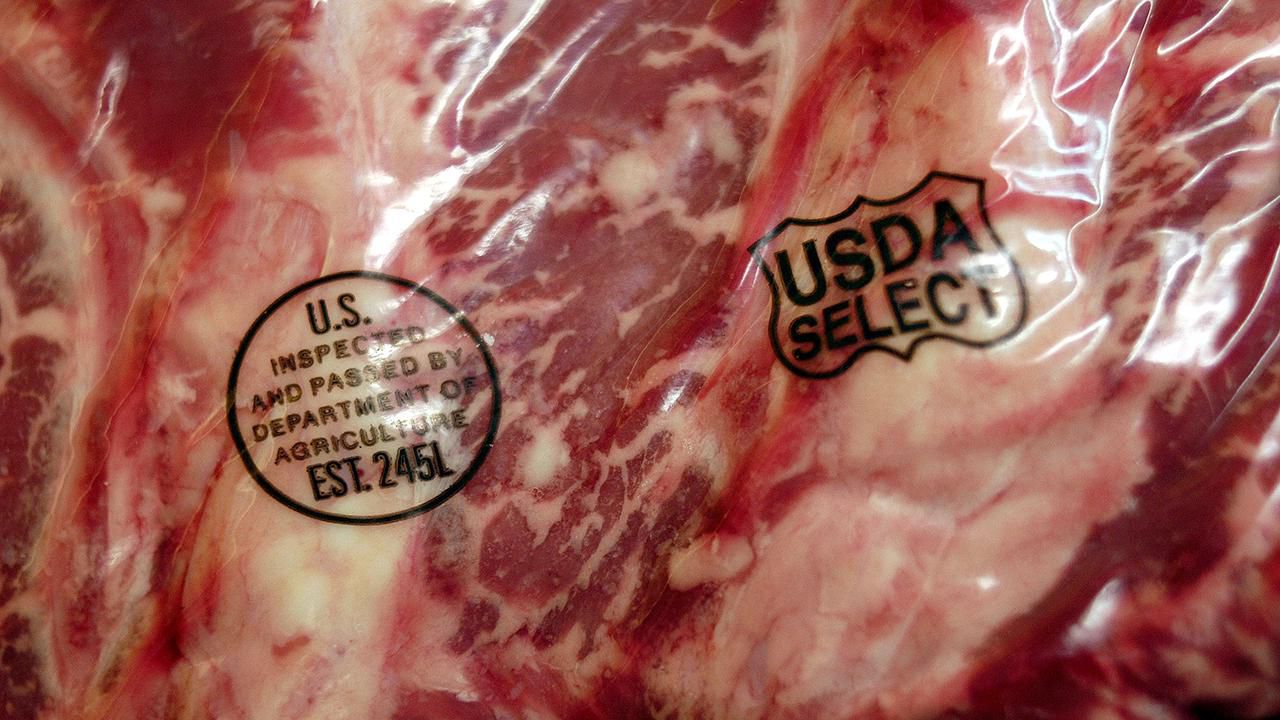
Based on marbling, which is a distribution of fat between individual muscle fibre of longissimus dorsi, muscle, fat color, meat color and maturity scoring provide a scale for assessment of physiological age of the animal. The pH is invariably determined after chilling the carcass for 24 hrs which measure the lactic acid in the muscles. The pH is measured by a pH Probe and the optimum level of pH in the meat should be 5.7
Labelling of Meat in India: –
Every now and then we come across the words- Jhatka and Halal. both are methods of slaughtering animals for consumption in two different communities. While Muslims follow the practice of Halal, the Hindu & Sikh community prefers Jhatka meat.
What is halal meat?
The term Halal in Arabic means- fit for human consumption. Following is the meaning and ideology- Muslim community consumes Halal meat. The process involves a swipe with a sharp blade across the animal’s neck. In Halal, the animal is slaughtered slowly with holy lines from Quran. The process involves the complete draining out of the animal’s blood. Islam has strict laws on the proper method of slaughtering an animal. One, called dhabihah, requires a swift, deep incision with a sharp knife on the neck that cuts the jugular vein. According to the Halal Food Authority, Stunning cannot be used to kill an animal but many Supermarkets selling halal products say they stun all animals before they are slaughtered. Stunning of livestock has been mandatory in the the EU since 1979, although member states can grant exemptions for religious slaughter.
What is Jhatka meat?
The term Jhatka, in Hindi means-swift. In this process, the animal’s head is severed in one single blow and the animal dies instantly. Halal has been the traditional method of killing animals for meat. It’s only in the early 20th century that Sikhs of Punjab propagated jhatka as a ‘less painful way’ of killing the animal.
For the meat to be tender and juicy, the pH count in the animal should ideally be around 5.4 after slaughter. “Struggle leads to the utilisation of stored energy, making the pH count rise to as high as 7,” In halal¸ the struggle is lesser by at least 20 per cent, claims a Delhibased nutrition expert.
Comparison between Halal Meat & Jhataka Meat
According to health experts, Dr V K Modi, head of department of meat technology at the Central Food Technology Research Institute in Mysore, says the halal method is effective in draining out most of the blood from a slaughtered animal, which is vital if its meat is to be soft. “In jhatka, chances of blood clotting are higher. This could spoil the meat if it’s kept uncooked for a few days. It could also make the meat tougher to chew.”
Ironically, in most Indian abattoirs, animals are first stunned with 70 volts of electricity in the brain, leaving them unconscious. “The animal’s state of unconsciousness reduces its struggle. However as per the Islamic code of slaughter/Halal doesn’t approve of stunning, the purpose of slaughtering is to release all blood from the animal’s body, leaving no room for growth of micro-organisms. When stunned, only a part of its blood is released.”
How to determine the Qualities of Meat:
Meat quality is defined by the yield, compositional, technological, wholesomeness and palatability characteristics such as appearance, juiciness, tenderness and flavour. The relative importance of these quality characteristics differs for different type of consumers.
- Meat should be safe to eat, free from parasites, microbial pathogens and hazardous chemicals. There is growing concern among the consumers that meat should come from animal that are reared and slaughtered as per approved norms and laws.
- This comprises of the quantity of salable meat obtained from meat animal, ratio of fat to lean, and muscle size and shape. Minimum level of fat is desirable as majority of consumers prefer higher ratio of muscle to fat. In another words, the amounts of lean that can be recovered from carcass indicate the quality of meat. This is also important from economic point of view.
- The visual identification of quality meat is based on color, marbling and water holding capacity. The meat should have a normal colour that is uniform throughout the entire cut. In general, colour of meat should be bright red or pink. Brown, purple or grey colour of meat is not desirable.
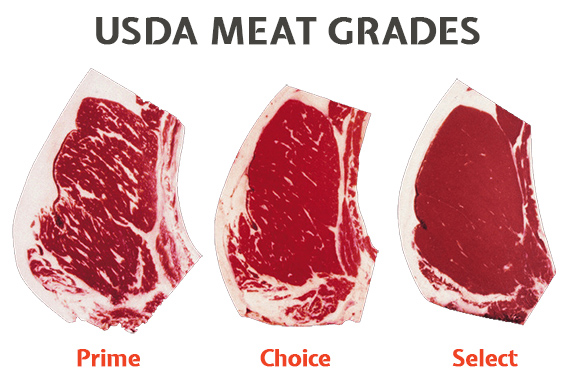
- Muscle tissue should also have marbling, i.e., small streaks of fat within the muscle. The marbling will increase the juiciness, tenderness and flavour the product.

- pH and water holding capacity are two important technological characteristics of meat. These ultimately influence the cooking yield, juiciness and tenderness of meat. Water holding capacity can be witnessed by carefully observing the meat surface or bottom of the retail package. There should not be any excess water oozing out of meat surface. Higher water holding indicate more yield and higher juiciness of cooked product. Type and level of fat and chemical composition of lean also greatly influence the technological characteristics of meat.
- Meat flavour is believed to be due to the breakdown products of ATP or energy, sulfur and nitrogen compounds and water soluble components of the muscle. Each species have a slightly different flavor due to difference in composition of fat within the muscle. Animals with different uses and different diets will deposit fat that contains different products. The fat melts during cooking and gives each species its own distinctive flavour.
UNDERSTANDING THE BASIC CUTS
Meat cuts are based upon two factors;
1 The muscle and bone structure of the meat.
2 Uses and appropriate cooking methods of various parts of the animal.
Available forms of Meat : Carcasses, Partial Carcasses, Primal and Fabricated Cuts.
Carcasses
The carcass is the whole animal, minus entrails, head, feet and hide (except pork, which has only the entrails and head removed). Whole carcasses are rarely purchased by food service operators because of the skill and labour required in cutting, and because of the problem of total utilization.
Lamb carcass
Primal & Fabricated cuts:-
These represent the first step in breaking down the carcass. Again these larger cuts are no longer frequently used in food service. Fewer establishments are cutting their own meats. These are the primary divisions of quarters, foresaddles, hindssaddles and carcasses. These cuts are still used to some extent in food service.
Each primal cut may be fabricated or cut up or trimmed, in several different ways. They are always the starting point for smaller cuts. Primal cuts are fabricated into smaller cuts for roasts, steaks, chops, cutlets, stewing meat, ground meat and so forth according to customer requirements.
some basic things which needs to keep in mind while purchasing meat:-
- Always buy the Right Cuts of Meat:- Good meat comes from the back of the animal that is from the loin, rib and rump. This part is usually a lot more tender than the front part which includes the legs, flank and shoulder. The good meat which comes from the back is available in smaller portion and that is why it is high in demand and is more expensive than other parts. The good cuts also get cooked faster on high flame whereas the meat from the front is more chewy and takes longer time to get cooked.
- Appearance of Meat:- While purchasing meat, you should keep in mind that it should be very high in tenderness, juiciness, and flavour. It should be virtually free from defects such as bruises, discolourations, feathers and should not have broken bones. There should be no tears in the skin or exposed flesh that could dry out during cooking. The surface of the meat should not be too dry or too wet, neither should it have any blood splashes on it.
- Colour:-The natural colour of the meat should be bright red, except the poultry one. The meat which is not fresh will no longer show the bright red colour. Sometimes due to the partial destruction of the red meat pigment, it results in the brown, grey and greenish colour of the meat.
- Smell:-The smell of the fresh meat is slightly acidic. Anything that smells rancid should be avoided completely. So, don’t forget to touch and smell the meat while buying.
- Firmness:-Any meat which is fresh will neither be too soft nor too tough. test it by poking it. It should slightly get pressed and then should come back to its original shape. Anything which doesn’t come back to the original shape or is too tight to poke has definitely been on the shelf for long.
Meat in India
People, especially in India, have often associated lamb with meat from sheep, and mutton with meat from goat. Meat from goat is actually called chevon. the word mutton is used interchangeably between sheep and goat, but since Indians mostly consume goat, it is the widely accepted term for goat meat. Since we hardly eat sheep. In almost all of India, mutton means the meat of the goat.
Mutton and lamb are highly nutritious, with both providing a high amount of protein. However, mutton contains a higher fat content as compared to lamb. Consuming high fat foods regularly can be detrimental as it builds up cholesterol in the arteries which can lead to heart diseases. Although mutton is a more popular dish than lamb because of its preferred strong flavour, lamb is a healthier choice, although both should be consumed in moderation for optimum health. While lamb is more popular in North America and mutton is more popular in Europe and the Middle East.
What is Goat Meat?
Goat meat (Khashi) is the meat of the domestic goat Goat meat is the most popular meat in the world and it is absolutely delicious. It is considered a red meat, with a fine-grained flesh and ranges in color from light pink to bright red. Goats bred for their meat are usually castrated (known as wethers) when they are around six to nine months. Most are slaughtered when they are under a year for a tender, juicy meat with a delicate flavour. meat from an un-castrated goat tends to be tougher, with a rather strong ‘goaty’ smell and flavour.
Goat meat is also a major delicacy in Nepal, and both castrated (khashi-ko-masu) and uncastrated (boka-ko-masu) goats are sacrificed during Dashain, the largest annual celebrations in the country, as well as on other festive occasions.
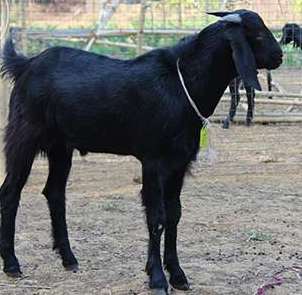 |  Meat from Indian Goat |
Goat meat is actually lower in calories, saturated fats, and cholesterol than beef, pork, lamb and chicken. It also contains a higher amount of protein and more iron than other Red meat.
Lamb and Mutton in other countries: –
In rest of the countries Lamb & Mutton are often associated with meat from Sheep. While lamb is more popular in North America and mutton is more popular in Europe and the Middle East, meat from goat is not favourable in any particular geographical location. Most sheep meat sold in the UK and US is lamb because mutton is not as popular.
What is Lamb?
Lamb is sheep that is less than a year old. It is typically slaughtered when it is between four and 12 months old. The color of the meat ranges from pale pink to pale red and is generally lean. Its mild flavor also makes it versatile. Ground lamb can be a great substitute for ground beef, lamb chops make an easy weeknight dinner, and a leg of lamb is a welcome change from the usual pork shoulder.

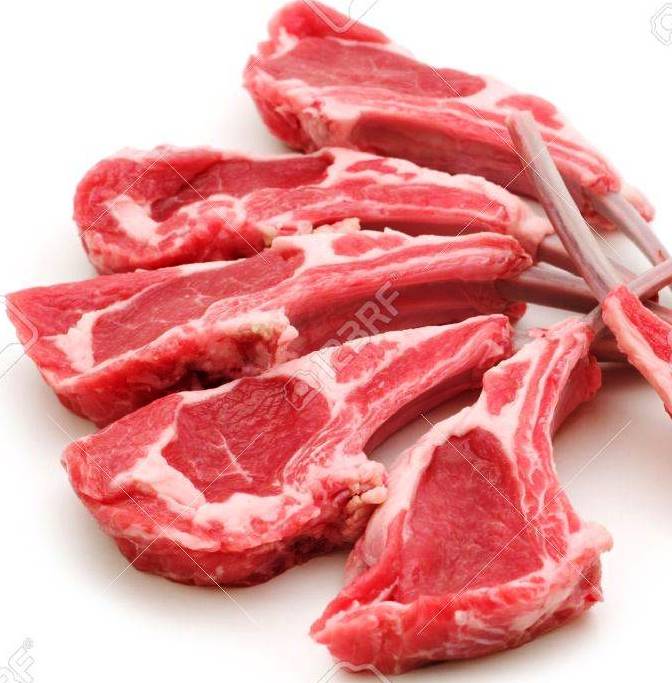
Lamb pic (source-global meat news) Lamb meat pic.(Pic source-123RF.com)
Spring lambs, are milk-fed lambs. They are born in the winter and sold in Spring (around Easter). Baby lamb meat will be pale pink, while regular lamb is a darker pinkish-red. The flavour and texture is the mildest and most tender and therefore fetches higher prices than that of older lamb or mutton.
What is Mutton?
The meat of an adult sheep is mutton. The adult sheep is typically slaughtered around two to three years old.The meat has a deep red color and is much fattier than lamb. Mutton has a deep red colour and is fattier than lamb. It is also tougher and the flavour is stronger and more gamey. This is because it contains a higher concentration of fatty acids which intensify as the animal becomes older. Mutton is now considered a slightly old fashioned meat as more lamb is consumed.
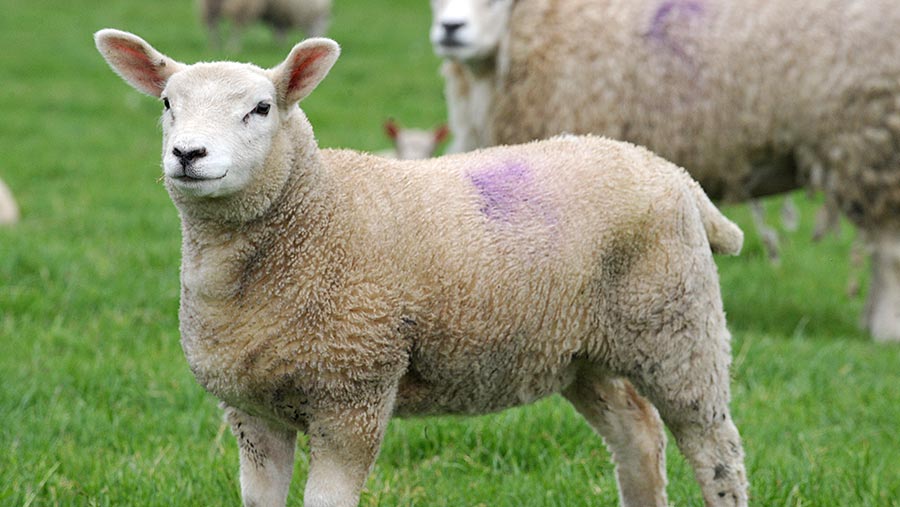
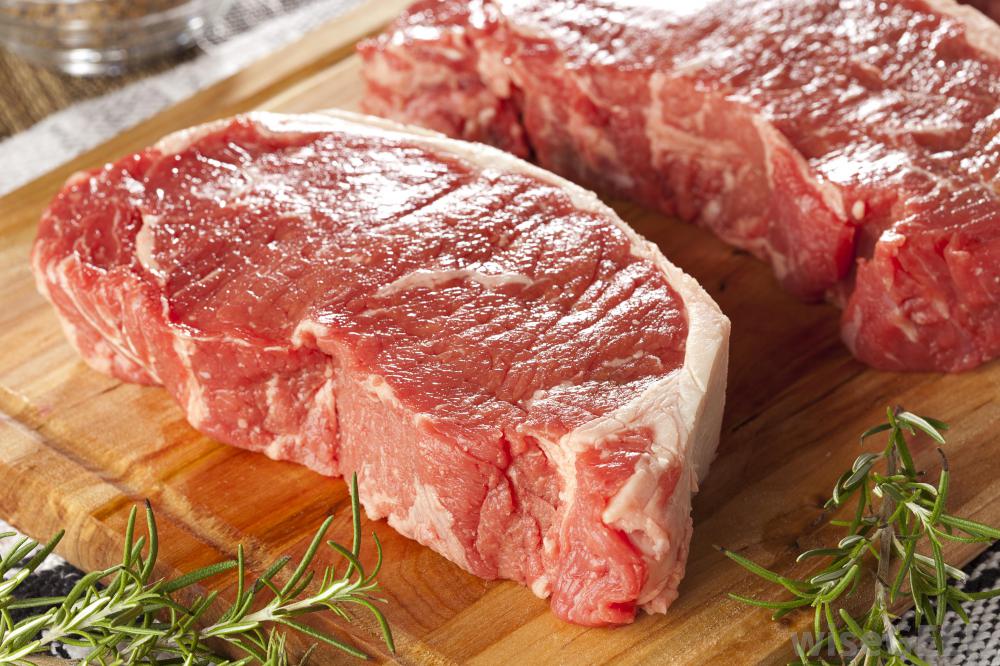
Adult Sheep (Mutton) Mutton Meat (Pic source-wisegeek)
Which one is better Goat Meat or Sheep meat:-
Goat meat is also significantly healthier than sheep meat. Goat meat has a stronger flavour to it and Lamb is a lot tender as compared to Goat meat. It contains lesser calories, saturated fats, and cholesterol than not only sheep meat, but also than chicken. It also contains more protein and iron than sheep, making it a more beneficial meat choice.
What is Pork
“Pork is a lean meat which is high in protein and fibre content. Pork is the culinary name for the meat of a domestic pig. Pork is eaten both freshly cooked and preserved. Pork, usually slaughtered between the ages of six months and one year. The most desirable pork is grayish pink in colour, firm and fine-grained, well-marbled, and covered with an outer layer of firm white fat. About 30 percent of the meat is consumed as cooked fresh meat; the remainder is cured or smoked for bacon and ham, used in sausage, and rendered to produce lard.
Because pigs may be infected by the parasitic disease trichinosis, pork must be cooked to an internal temperature of 160 °F (71 °C) in order to destroy the disease-causing organism.


Pork Meat Pic (Pic source-Healthline)
Pork meat & its consumption in India.
For the longest time in India, pork eaters have been a minority despite the fact that the meat is widely consumed in many parts of the country (including the North Eastern states, Goa, Karnataka and Kerala) and by several communities (including the Catholics and Kodavas). The pig’s scavenging ways brought it bad press – many people consider it impure, irrespective of religion – and it was off limits in many kitchens. Restaurants too were wary of putting it on their menu.
Pork consumption persisted in tribal or lower-caste communities until it was reintroduced in India first by the Portuguese in Goa, and later by the English across the rest of India. The British were determined to have their breakfast bacon, and this was despite problems finding cooks to prepare it. Many cooks were Muslims, who refused to handle pork, and upper-caste Hindus wouldn’t handle most meat dishes either.
This lead to a demand for Christian cooks from Goa or, in eastern India, the ‘Mug’ cooks from tribes who had no problem with pork. The problem for such elite consumers in India has always been ensuring their pork came from the superior pigs of the English farms, and not the sort commonly seen in garbage heaps across the country. in western style cafés and the restaurants and pop-ups created by cooks from the Northeast, whose quiet spread across India is increasing demand for pork. (This is in addition to Chinese restaurants, which usually serve pork.) This demand is being supplied by a growing number of modern pig farms in states like Punjab and Haryana. These are raising western breeds like Yorkshire to Landrace pigs, sometimes cross-bred with Indian breeds.
“In the past decade, there has been a huge demand for pork meat in the north Indian market used for making bacons, sausages etc. with the opening of international chain of restaurants, awareness among globetrotting Punjabis and availability of it in local retail stores. Gurgaon-based Ample Foods, which sells under the Prasuma brand name, is a major supplier of raw and processed pork in the north Indian market. “It’s the tastiest meat and people are gorging on it. Demand for bacon, sausages and salami has been increasing and the only challenge. Between 2010 and 2015, India’s imports of pig meat increased at an average annual rate of 11 percent. While demand from high-end hotels, restaurants and retailers is driving imports of pork products to India, there is a largely separate but significant market for locally produced pig meat in north-eastern states – which include Assam, Nagaland, Arunachal Pradesh, Manipur, Meghalaya, Mizoram, Sikkim and Tripura – as well as in Bihar, Jharkhand, West Bengal, Goa and Kerala
Pork & pork meat consumption in world:-
Pork is one of the most versatile of meats and is consumed around the world. Because it is proscribed by the dietary laws of Judaism and Islām, however, pork is virtually unknown in the cuisines of the Middle East and those of some local populations in Asia and Africa. The chief pork-consuming countries (on a per capita basis) are Germany, Denmark, Poland, and Austria.
In Western cooking fresh pork is commonly roasted, choice cuts being the loin, leg, and rib sections known as spareribs. Chops from the loin and ribs are usually grilled or pan-fried. A spit-roasted whole young piglet, or suckling pig, is a delicacy in central and eastern Europe; wild pigs have traditionally been cooked in a similar manner throughout the Pacific.
In united states Pork carcasses are graded according to the amount of edible meat they will yield.
- Number 1 carcass is one having the most satisfactory ratio of fat to lean.
- Number 2,3 & 4 have a higher proportion of fat, reducing the amount of lean. Utility-grade pork, which is usually from mature animals, has too little fat and is less firm.
In China and Southeast Asia pork is commonly shredded or cubed and stir-fried with vegetables and spices. Pork-and-vegetable mixtures are also used to stuff a variety of small rolls, buns, and dumplings.

Prime cuts of Pork Meat.
